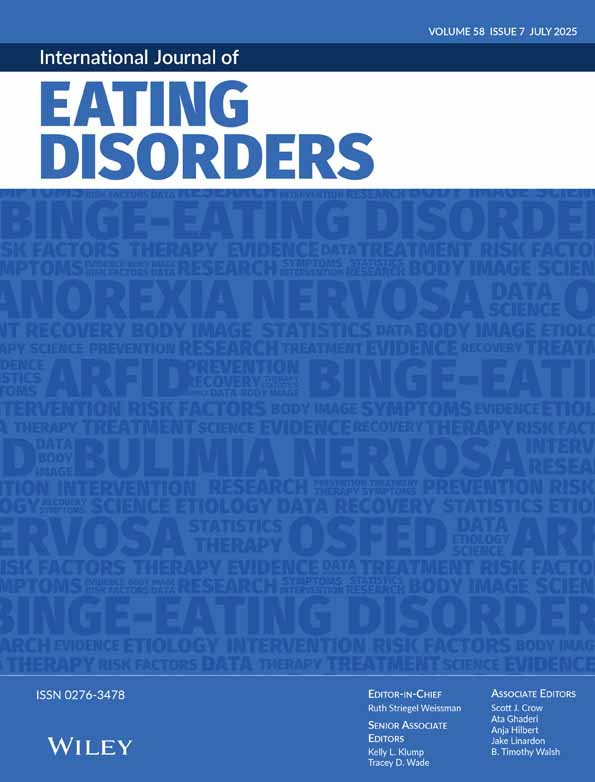Article
Full Access
Separation-lndividuation difficulties and the distinction between bulimia nervosa and anorexia nervosa in college women
Linda Smolak,
Michiel P. Levine,
Corresponding Author
Linda Smolak
Department of Psychology, Kenyon College
Department of Psychology, Kenyon College, Gambler, OH 43022Search for more papers by this authorLinda Smolak,
Michiel P. Levine,
Corresponding Author
Linda Smolak
Department of Psychology, Kenyon College
Department of Psychology, Kenyon College, Gambler, OH 43022Search for more papers by this authorFirst published: July 1993
Citations: 28
14:1<33::aid-eat2260140105>3.0.co;2-d.fp.png)
References
- American Psychiatric Association. (1987). Diagnostic and statistical manual of mental disorders ( 3rd ed., revised). Washington, DC: Author.
- Armstrong, J. G., & Roth, D. M. (1989). Attachment and separation difficulties in eating disorders: A preliminary investigation. International Journal of Eating Disorders, 8, 141–155.
-
Earth, F. D.
(1989).
Separation-individuation, sense of self, and bulimia in college students.
Journal of College Student Psychotherapy,
3, 135–149.
10.1300/J035v03n02_10 Google Scholar
- Bruch, H. (1973). Eating disorders: Obesity, anorexia nervosa, and the person within. New York: Basic Books.
- Crisp, A. H. (1980). Anorexia nervosa: Let me be. London: Academic Press.
- Friedlander, M. L., & Siegel, S. M. (1990). Separation-individuation difficulties and cognitive-behavior indicators of eating disorders among college women. Journal of Counseling Psychology, 37, 74–78.
- Garner, D. M. (1991). Eating Disorder Inventory-2: Professional Manual. Odessa, FL: Psychological Assessment Resources, Inc.
- Garner, D. M., & Fairburn, C. G. (1988). Relationship between anorexia nervosa and bulimia nervosa: Diagnostic implications. In D. M. Garner & P. E. Garfinkel (Eds.), Diagnostic issues in anorexia nervosa and bulimia nervosa (pp. 56–79). New York: Brunner/Mazel.
- Garner, D. M., Olmsted, M. P., & Garfinkel, P. E. (1983). Does anorexia nervosa occur on a continuum: Subgroups of weight-preoccupied women and their relationship to anorexia nervosa. International Journal of Eating Disorders, 2, 11–20.
- Garner, D. M., Olmsted, M. P., & Polivy, J. (1983). Development and validation of a multidimensional eating disorder inventory for anorexia nervosa and bulimia. International Journal of Eating Disorders, 2, 15–34.
- Grotevant, H., Cooper, C. (1985). Patterns of interaction in family relationships and the development of identity exploration in adolescence. Child Development, 56, 415–428.
- Halmi, K. A., Casper, R. C., Eckert, E. D., Goldberg, S. C., & Davis, J. M. (1979). Unique features associated with age of onset of anorexia nervosa. Psychiatry Research, I, 209–215.
- Hoffman, J. A. (1984). Psychological separation of late adolescents from their parents. Journal of Counseling Psychology, 31, 170–178.
- Hoffman, J. A., & Weiss, B. (1987). Family dynamics and presenting problems in college students. Journal of Counseling Psychology, 34, 157–163.
-
Hsu, L. K. G.
(1990).
Eating disorders.
New York:
Guilford.
10.1007/978-1-4899-0894-0_19 Google Scholar
- Humphrey, L. L. (1986). Structural analysis of parent-child relationships in eating disorders. Journal of Abnormal Psychology, 95, 395–402.
- Humphrey, L. L. (1989). Observed family interactions among subtypes of eating disorders using structural analysis of social behavior. Journal of Consulting and Clinical Psychology, 57, 206–214.
- Johnson, C., & Connors, M. E. (1987). The etiology and treatment of bulimia nervosa: A biopsychosocial perspective. New York: Basic Books.
- Keppel, G. (1991). Design and analysis. Englewood Cliffs, NJ: Prentice-Hall.
- Lapsley, D. K., Rice, K. G., & Shadid, G. E. (1989). Psychological separation and adjustment to college. Journal of Counseling Psychology, 36, 286–294.
- Maine, M. (1991). Father hunger: Fathers, daughters & food. Carlsbad, CA: Gurze Books.
- Olver, R., Aries, E., & Batgos, J. (1989). Self-other differentiation and the mother-child relationship: The effects of sex and birth order. Journal of Genetic Psychology, 150, 311–321.
- Phares, V. (1992). Where's poppa? The relative lack of attention to the role of fathers in child and adolescent psychopathology. American Psychologist, 47, 656–664.
- Rhodes, B., & Kroger, J. (1991, April). Parental bonding and Separation-individuation difficulties among late adolescent eating disordered women. Paper presented at the Biennial Meeting of the Society for Research in Child Development, Seattle, Washington.
- Rice, K., Cole, D. A., & Lapsley, D. K. (1990). Separation-individuation, family cohesion, and adjustment to college: Measurement validation and test of a theoretical model. Journal of Counseling Psychology, 37, 195–202.
- Wonderlich, S. (1992). The relationship of personality disturbance and family functioning in bulimia nervosa. In J. H. Crowther, S. E. Hobfoll, M. A. P. Stephens, & D. L. Tennenbaum (Eds.), The etiology of bulimia: The individual and familial context (pp. 103–126). Washington, DC: Hemisphere.
- Wooley, S. C., & Wooley, O. W. (1985). Intensive outpatient and residential treatment for bulimia. In D. M. Garner & P. E. Garfinkel (Eds.), Handbook of psychotherapy for anorexia nervosa and bulimia (pp. 391–430). New York: Guilford Press.




